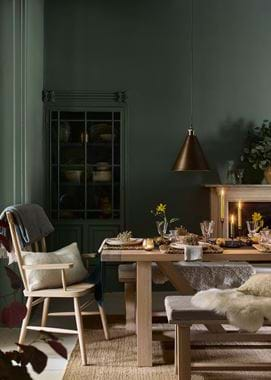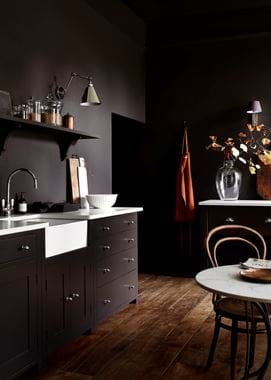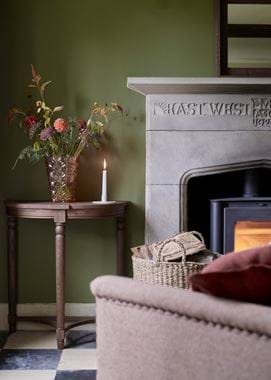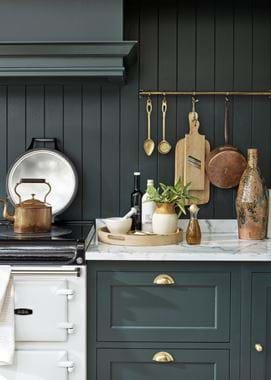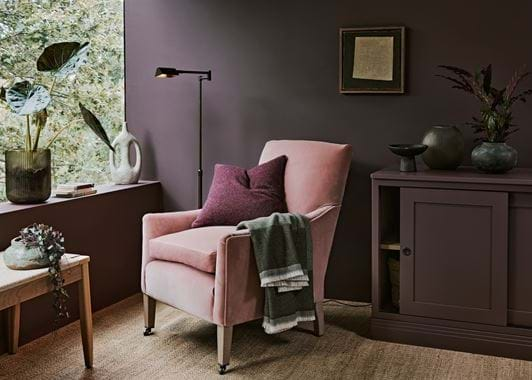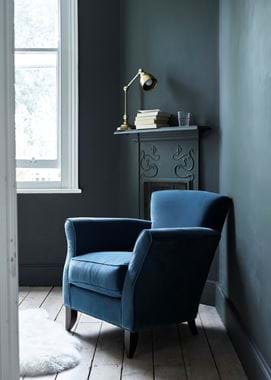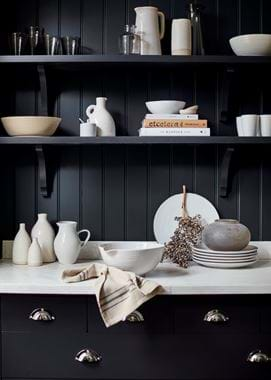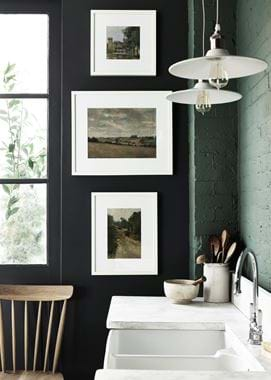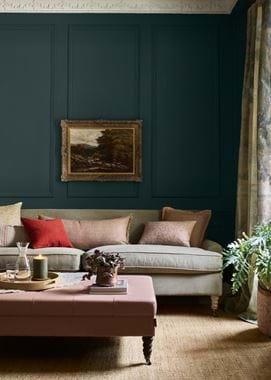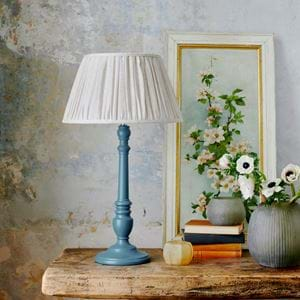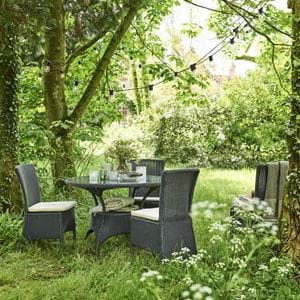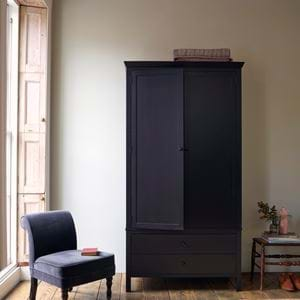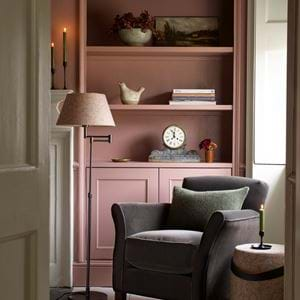Painting with dark tones
Painting with dark tones
The move towards using darker colours on the walls in our homes has gathered pace over the last few years. Feature walls were the stepping stone – a way to bring in a darker tone, but with the safety net of more familiar, lighter shades surrounding it. Then kitchen cabinetry became a place to experiment with deeper shades like charcoal grey, navy and bottle green. Having lots of appliances, work surface space and crockery or glassware on display means the depth of colour is easily broken up and feels a touch less daunting. But now, our homes are gradually getting braver at taking on darker paint colours. We’re using them in bigger ways. We’re letting paint bring out our courageous side. If you’ve been tempted by the dark side, read on for inspiration on how to use our deepest shades in a confident way.
The effects of blanket colour
If you’re feeling especially brave, using dark tones in a continuous way, from skirting and radiators to walls, cornicing and yes, potentially even the ceiling, is a beautifully enveloping application of colour.
A big reason you might want to go down this route is if you have any architectural features in the room that you want to hide. That might be doorframes of different heights, awkward angles, or plain skirting. Painting them all the same colour as the walls means that they just sort of blend together and become less noticeable. You can, of course, do this with a lighter colour too, but it’s a particularly effective trick for dark colours because even the most muted of off-whites on woodwork or radiators will be a distinct contrast.
Similarly, you can also do this to visually alter a room’s proportions. Dark all over is a look that works just as well in a small room – where a strong contrast between the walls and other elements can make the room feel ‘bitty’ and busy – as in large rooms, where a strong shade all over will absorb light and create intimacy. Likewise, by painting the ceiling the same colour, you create an optical illusion that’s particularly effective at making low ceilings disappear by blurring the boundaries between where walls end and ceiling begins.
Our Suffolk kitchen scene shows how using Walnut on every surface (as well as a dark timber floor), in a room that’s medium-sized and with a good amount of light (not flooded, but neither sombre) works wonders. The single use of colour means that every part of the kitchen flows into the next, making a practical and sometimes busy space feel more harmonious. Meanwhile the Constable Green dining room demonstrates how one colour can unite walls and woodwork and create a space with a contemporary sort of minimalism, even in a period home.
How to choose complementary neutrals
If you do want to use dark paint on all your walls but don’t want to carry it onto woodwork and ceilings as well, then you’ll need a suitable neutral to colour these areas instead.
The principles of choosing one are as with any other colour: pick out the undertone of your wall shade and then choose a neutral woodwork/ceiling colour with a similar base. So, with warm purple-brown Clove, we might choose Salt which has a complementary touch of pink to it. Or with cooler blue-green Constable Green, choose crisp Snow.
There are three ‘bright’ whites – Snow, Salt and Shell – in our core collection, as well as three more off-whites – Lily, Silver Birch and Old Chalk – and they range from the cleanest (Snow) to those with hints of warm or cool grey (Shell, Lily and Silver Birch) and yellow (Old Chalk) so there’s one to suit every darker colour.
For a failsafe option, choose a neutral from within the same palette (you’ll know that Silver Birch is perfect for Walnut because they’re both in the Timber palette). Or, if you’re using an archive shade, experiment with tester pots in your room’s light – the best way to whittle decisions down.
Bright and off-whites aren’t your only option for woodwork and ceilings though. Sometimes, with a very dark wall colour, a more pigmented neutral is the way to go. Honed Slate might look quite dark on its own, but put it up next to Olive and it recedes into the background happily. Ditto with Driftwood and Clove, and Lily and Constable Green. And just look at the difference between Ink with Snow and Ink with Shingle.
A balance between blending and contrasting
Whether you extend your chosen dark colour onto woodwork and ceilings or you go for a complementary neutral, decorating doesn’t stop there. Now you get to experiment with the effects created by furniture, fabrics and accessories.
When you use a dark colour on your walls, it can be quite striking to have other elements in the room in the same (or a very similar) colour but a contrasting texture. Picture a sofa in one of our deepest velvets against a wall in an equally as bold, coordinating shade (try Ink with Swallow, Walnut with Grouse and Steel with Constable Green). It means the sofa melts into the wall with just the lustre of the velvet whispering their separate existence. And if you’re not keen on velvet? Other fabrics can have a similar effect, like our Linara at Neptune linen-cotton in Dark Fig, which has a brushed texture that subtly picks up on light and would pair well with walls in Clove. Or you could choose to try this technique using painted furniture, with matt emulsion on the wall and the contrast of eggshell’s subtle sheen on the furniture.
That said, don’t have everything in the room in the same colour, or there won’t be anything to excite the eye. Think of colour contrasts as the squeeze of lemon in a dish that enlivens all the other flavours. The white mounts on framed artworks and the milky glaze of pottery are both easy ways to do this. Or, as we touched on with paint earlier, if you’d like less of a contrast, choose timbers and other natural materials to do the job (Constable Green, for instance, works especially well with the warm tones of oak or our Whittington rugs). Don’t forget other colours can add the element of difference you need as well – Old Rose with Clove, for instance, or Saffron with Ink. And make use of metals, mirror and glass too, which will highlight as they catch the light.
The confident use of dark paint can be mellow or it can zing with drama. It’s all in how you use it.
Explore all our darkest paint colours and order samples online here.

